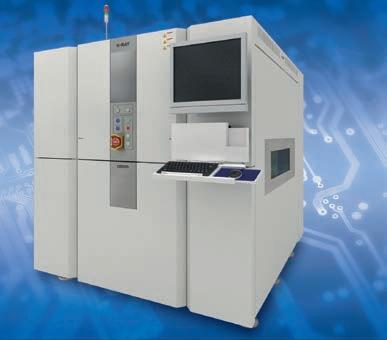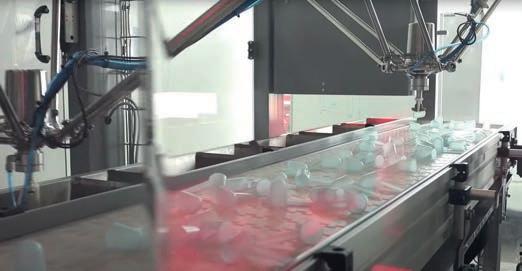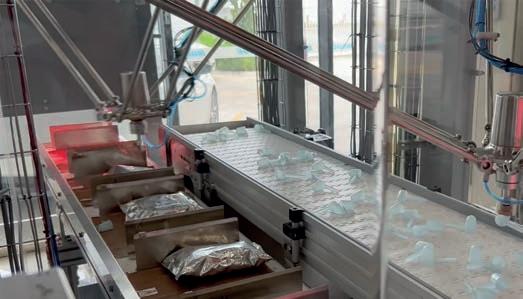
6 minute read
INSTALLATIONS
Latest x-ray inspection system is guaranteeing PCBs’ performance
To ensure top inspection quality of its PCBs used in automotive applications, Robert Bosch GmbH is using Omron’s third generation of the VT-X750 3D x-ray inspection system.
Advertisement
It is based on ultra-high speed computed tomography (CT) to guarantee precise and reliable inspection of hidden soldering areas during production. Solder defects such as ‘head in pillow’ or void in BGA, LGA, THT, and other discrete components can be detected more easily than with other tomographic methods, says Omron. The image quality of the CT process, for example, is significantly higher than with Laminography or even tomosynthesis.
Automotive applications demand increasingly higher quality standards to comply with autonomous drive system control levels 4 and 5 by 2025. As a result, the development of components has become more sophisticated and powerful, where PCBs become smaller in this context, while their assembly density is increasing.
One hundred percent reliable PCBs are essential because of high quality and safety requirements. Due to the immense complexity of automotive components, the need for automatic and high-quality testing has increased where International automotive groups impose strict requirements on the quality of inspection technology. With the VT-X750 3D-AXI AVL devices used by Bosch, the inspection can be performed without stopping the assembly. This ensures high speed with better resolution. Meanwhile, the CT process provides true 3D data that
This latest version inspects any hidden soldering areas operators and programmers can also use. Fault-free processes are the focus of the VT-X750 units, the latest 3D CT AXI technology on the market. Technical improvements have enabled enhanced improvements in cycle times by up to 1.5 times faster compared to the previous VT-X750 models, enabling the new VT-X750 to be the first viable in-line CT AXI solution. Added to this are clever AI functions that reduce programming time and take a lot of effort out of the operator’s programming where BGA’s are created in less than 60 seconds including automatic extraction for accurate measurement. VT-X750 software adjusts the contrast image by automatically correcting the x-ray tube voltage as well as current exposure time, and CT value. Self-propelled systems can be connected.
Omron believes the VT-X750 supports Bosch and other users with advanced inspection for PCBA design without design limitations. Added to this are full 3D CT data processing and implementation of IoT projects for manufacturing. It thus makes a valuable contribution to streamlining PCB inspection, strengthening quality in the automotive sector, relieving employees, and improving overall safety in general. T 01908 258258 W www.industrial.omron.co.uk
An integrated bag filling and palletising system supplied to a decorative aggregates producer has provided supply gains
RMGroup has installed a fully integrated bag filling and palletising system for specialist decorative aggregates supplier, Long Rake Spar to help the company fully control its supply chain. The solution is capable of producing up to 40 bags a minute and over 2200 pallets of bagged aggregate a week.
To meet the required throughput of aggregates, the automated bag filling and palletising system for bagging conveyors, two doser weighing systems and vertical form, fill and seal (VFFS) bag filling systems with operator platforms. The filled bags are The VFFS bag filling systems have operator platforms positioned onto pallets by up to 25 kg bags, consists of two ABB IRB 460 palletising twin bulk hoppers and in-feed systems with gripper heads and safety systems.
Palletised loads are conveyed to the end of the line and wrapped by a Lachenmeier Powerflex T1 stretch hooder.
“The new bagging plant fully meets our expectations, the installation of which was highly professional throughout,” says Kenny Dean, Long Rake Spar’s procurement and logistics director. T 01686 621704 W www.rmgroupuk.com

Measuring spoons for baby food are handled by an hygienic robot
Malaysian-based system integrator MODU System opted for a KR DELTA from KUKA to handle measuring spoons for baby foods.
Two KR DELTA robots pick up measuring spoons from a conveyor belt and place them on a second belt in open conveyor pockets, each holding a food bag with baby food. In a free area next to each bag, a sticker includes a bar code. “When the robot detects the free area via the camera, it knows to place a spoon there,” explains Rajinderjit Singh, regional recognition and KUKA. PickControl, work with high precision, avoiding potential manual errors.
One of the biggest initial challenges for this process was accurate calibration. This is a precondition for the two KR DELTAs to grip the spoons with precision at high speed. Before this installation, the baby food manufacturer carried out this process in a potentially dangerous manual way.
“The customer has great confidence in the automation
manager of MODU System.
Another machine then pushes the bag and spoon into a box. “Naturally, the solution centres on the KR DELTA, which can come into direct contact with food because of its stainless steel body,” explained KUKA employee Lim Jia Ming.
With a cycle time of as little as 0.5 seconds, the KR DELTA is extremely fast. “Two robots manage about 80 spoons per minute,” says Lim Jia Ming. At the same time, the robots and the KUKA software behind them, such as KUKA. VisionTech for 2D object solution that KUKA and MODU System have developed,” Singh explains. “We ourselves are impressed with the stainless steel design of the KR DELTA and believe that the application is ideally suited to the food industry, which places great emphasis on hygiene.
“The system is very easy to operate, looks good, and the stainless-steel robot design convinced our foodindustry customer.” T 0121 505 9970 W www.kuka.comBefore this new installation, the baby food spoons were handled manually

Packline third The KUKA KR DELTA robot can come into direct contact with all foodstuffs

www.packline.co.uk

■ Bespoke Design ■ Stainless Steel Construction ■ Compact and Manoeuvrable ■ Lifting Capacity up to 300kg ■ Interchangeable Attachments ■ Handle Reels of Film or Foil, Drums and Barrels

Rapid automated inspection saves millions of bottles being wasted Machinery Update, 149 x 225 mm, Digitalisation M, CC-en91-AZ169 09/22
UK integrator Bytronic Vision Automation has helped one glass manufacturer save millions of premium glass bottles from unnecessary destruction thanks to a new automated in-line inspection system that was deployed in under 48 hours.
After discovering a potential quality issue with a batch of its premium whisky bottles, the company needed to rework 4,000 pallets of stock – over three million bottles – in less than 10 weeks. The issue was the shape of the bottle neck. Each neck must exactly match the angle at which the whisky makers apply a cap and sleeve to securely seal the liquid inside.
ADDING AUTOMATION The customer identified one batch in which the shape of the neck may have been incorrectly made, but it was unclear as to how many bottles had been affected.
Using a pre-existing rework line, Bytronic engineers swapped the manual option with a rapid automated in-line inspection system – capable of checking five bottles per second – within 48 hours.
Three million bottles were checked, and roughly 60% were saved from the bin. That’s nearly two million premium bottles that would otherwise have been smashed, reformed and recycled needlessly, costing money, time and also energy.
The on-site quality product manager was pleasantly surprised by the accuracy and repeatability of the equipment. The company has never had any issues, and Bytronic has never let any bad glass get onto a finished pallet. T 01564 793174 W www.bytronic.com






